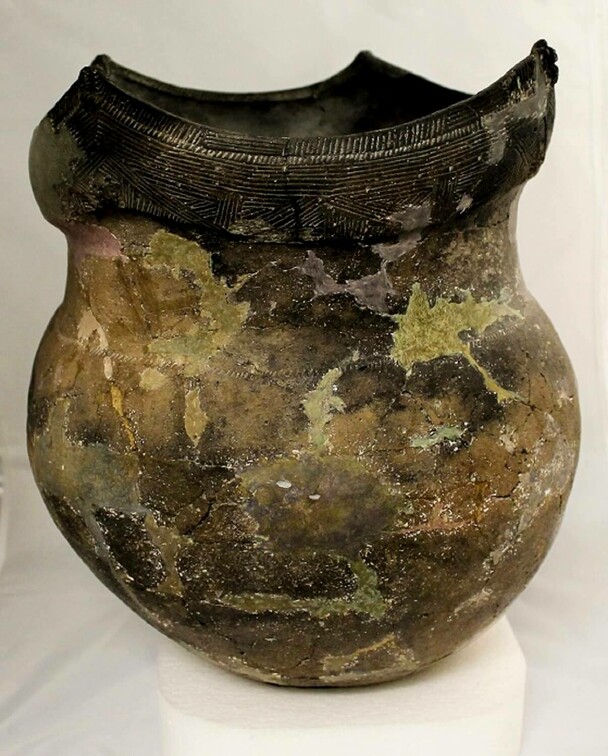Manomet Pot
- Date
- c.1500
- Material
- Earthenware, Native Ceramic with shell temper
- Author/Maker
- Artist’s name is no longer known. The pot was excavated by Jesse Brewer in 1942 and restored by Fredrick Johnson and the Peabody Institute of Archaeology.
- Source
- Plimoth Patuxet Museums Archaeology Collection

Description
Wampanoag ceramics represent a physical relationship between female artisans, their ancestors, and Mother Earth. Traditionally, women decorated clay cooking pots with geometric patterns, scalloped rims, ears of corn, and four points to pay homage to the cardinal directions, keeping a cultural tradition alive for more than 500 years. These vessels and their patterning symbolize more than an individual woman’s creativity; they echo women’s roles as life givers and nurturers in their communities and represent an unwavering connection to the Creator. Nosapocket (Ramona Peters) is a Wampanoag ceramics artist from Mashpee who still practices traditional pottery:
“balancing the male/female shapes physically and energetically gives birth to the spirit essence of each pot. The body of each pot is female, round and full. It is the place of nurturance where animal, vegetable, mineral plus the elements of earth, fire, water, and air combine to strengthen human life force. The collar or top of the pots are male which often have four points representing the four directions where we seek food and knowledge…these magical vessels enhanced food as medicine and increased our potential to become vessels of love and wisdom.” 1
Pottery making came into the area around Patuxet approximately 2,500 years ago. Before clay pots were used, pots for cooking were made of steatite (soapstone). There are no soapstone quarries in southeastern Massachusetts. The nearest ones are in the Providence, Rhode Island area; therefore, these heavy pots were distributed by trade. Examples of soapstone pots show up all over southern New England as well as on Nantucket, Aquinnah (Martha’s Vineyard), and Cape Cod. As knowledge of ceramics increased, the soapstone pot industry died out. Suitable clays for making pots were found locally throughout the region.
Wampanoag pottery is classified as earthenware, relatively soft as compared with stoneware or china. Around 1500, women made pots using the coil method, tempered with finely crushed shell or grit. According to Nosapocket, “pot builders were keenly aware of the chemical combinations best suited for their wares. By crushing specific rocks, shells and adding prepared solutions, they created clay bodies which attracted favorable magnetic energies from the atmosphere.”2 Today, Wampanoag women still decorate their pots in the traditional way using a variety of tools for incising and impressing designs before firing. Incised lines, punctuate designs, dentate designs, and modeling the “corn ear” motif were particularly common.
English writers including Thomas Morton and Daniel Gookin offered detailed descriptions of traditional clay ceramics. In 1637, Morton described the various sizes of ceramic pots ranging “from a quart to a gallon, 2. Or 3. To boil their vittels in; very strong, though they be thin like our Iron pots."3 A generation later in the 1670s, according to Daniel Gookin “now [the Indigenous people] generally get kettles of brass, copper, or iron. These they find more lasting than those made of clay, which was subject to be broken; and the clay or earth they were made of, was very scarce and dear."4
Local amateur archaeologist Jesse Brewer excavated this unique piece from the Cape Cod Canal in 1942. Frederick Johnson and The Peabody Institute of Archaeology (Andover, MA) restored the pot, and Brewer donated it to the Museum in 1980. It represents one of the largest and most intact Wampanoag cooking pots ever found.
Media

Discussion Questions
-
Whose role was it to make pottery?
-
How do English writers describe Wampanoag pots? Looking at the Manomet Pot, how would you describe it?
-
Compare this cooking pot to one you have at home. What is the same? What is different?
-
What do ceramic cooking pots like this tell us about daily life for Wampanoag women in the 1600s?
-
How did the arrival of Europeans change how Wampanoag women cooked?
-
How does Edward Winslow compare the Wampanoag cooking pots to ones he is familiar with?
-
Are any traditional crafts or objects passed down through your family?
Footnotes
- 1“Wampanoag Forms in Clay” Ramona Peters - Nosapocket. Accessed 3/21/23.
- 2 Ibid.
- 3 Thomas Morton. New English Canaan. (1637), (New York: Burt Franklin, 1967). p. 159.
- 4 Daniel Gookin. Historical Collections of the Indians in New England. (1674). (New York: Arno Press, 1972). p. 11.
